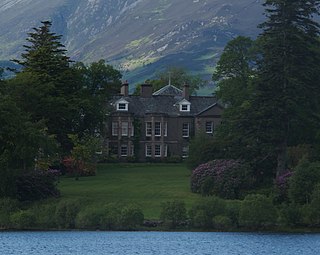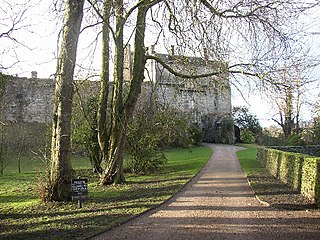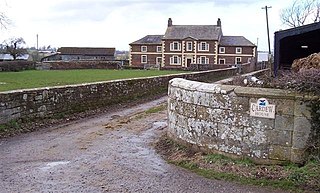
Cardew Lodge is a country house at Cardew near Thursby in Cumbria. It is a Grade II listed building. [1]

Cardew Lodge is a country house at Cardew near Thursby in Cumbria. It is a Grade II listed building. [1]
The house was built as a hunting lodge for Major-General William Henry Lowther following his retirement from the Bengal Army [2] in the late 1870s. [1] The house has "single-storey gabled wings reminiscent of an Indian bungalow, which he stuffed with mementos of his time in Bengal, including the skin of a crocodile shot after it had eaten a man, and he planted rhododendrons and azaleas in his garden." [3]
The house was acquired by C. J. Ferguson, an architect, who designed and commissioned additions in 1889. [1] In addition to the turreted tower which is built into the house, it has twin towers on the drive up to the house. [4] It became the retirement home of Barbara Dunn, the first British licensed radio operator, after the Second World War [5] and then became the home of the Mallinson family in 1980. [6]

Arthuret is a civil parish in the Carlisle district of Cumbria, England. According to the 2001 census it had a population of 2,434, increasing to 2,471 at the 2011 Census. The parish includes the town of Longtown and the village of Easton. It is bounded by the River Esk to the west and the River Lyne to the south.

Derwent Island House is a Grade II listed 18th-century Italianate house situated on the seven-acre (three-hectare) Derwent Island, Derwent Water, Keswick, Cumbria, and in the ownership of the National Trust. It is leased as a private home, but is open to the public five days a year. The interior is classical in style.

Levens Hall is a manor house in the Kent valley, near the village of Levens and 5 miles (9 km) south of Kendal in Cumbria, Northern England.

Dovenby Hall is a country house in 115 acres (47 ha) of land at Dovenby, about 2 miles (3.2 km) north-west of Cockermouth, Cumbria, England. It is a Grade II listed building.

Appleby Castle is in the town of Appleby-in-Westmorland overlooking the River Eden. It consists of a 12th-century castle keep which is known as Caesar's Tower, and a mansion house. These, together with their associated buildings, are set in a courtyard surrounded by curtain walls. Caesar's Tower and the mansion house are each recorded in the National Heritage List for England as a designated Grade I listed building. The uninhabited parts of the castle are a scheduled ancient monument.

Cockermouth Castle is in the town of Cockermouth in Cumbria on a site by the junction of the Rivers Cocker and Derwent. It is a Grade I listed building and a scheduled monument.

Greystoke Castle is in the village of Greystoke 8 kilometres (5.0 mi) west of Penrith in the county of Cumbria in northern England.. It is owned by the Howard family and is a private residence including a castle and family estate with no public access.

Cliburn is a village and civil parish in the Eden district of Cumbria, England. The civil parish includes the hamlet of Town Head. In 2001 the population was 204, increasing to 274 at the 2011 Census.

Rose Castle is a fortified house in the parish of Dalston, Cumbria, England. It was the residence of the bishops of Carlisle from 1230 to 2009, and has been a peace and reconciliation centre since it was sold by the Church Commissioners to the Rose Castle Foundation in 2016. The castle is a grade I listed building.

Dallam Tower is a grade I listed country house in Beetham parish, near Milnthorpe, South Lakeland, Cumbria, England. It is a member of the Historic Houses Association but is not open to the public except for occasional charity events, visits to the garden through the National Garden Scheme, and as a wedding venue.

Cardew is a hamlet in Cumbria, England. It is located southwest of Dalston, south of Cardewlees and east of Thursby.

Abbot's Wood was a large country house and estate located to the north-northeast of Barrow-in-Furness, Cumbria, England. It was sited on elevated ground to the northeast of Furness Abbey. The house was surrounded by extensive grounds with footpaths providing fine views.

Dalemain is a country house around 5 miles south-west of Penrith in Cumbria, England. It is a Grade I listed building. Dalemain is part of the Lake District UNESCO World Heritage Site.

Workington Hall, sometimes called Curwen Hall, is a ruined building on the Northeast outskirts of the town of Workington in Cumbria. It is a Grade I listed building.

Askham Hall is a country house near Askham in Cumbria. It is a Grade I listed building.

Dalston Hall is a fortified country house at Dalston in Cumbria, England. It is a Grade II* listed building.
Helsfell Hall was a country house near Kentrigg in Cumbria. That part of the building which survives, and is now used as a barn, is a Grade II listed building.

Cardew House is a country house at Cardew near Thursby in Cumbria. It is a Grade II listed building.
Dalston is a civil parish in the Carlisle district of Cumbria, England. It contains 93 buildings that are recorded in the National Heritage List for England. Of these, three are listed at Grade I, the highest of the three grades, four are at Grade II*, the middle grade, and the others are at Grade II, the lowest grade. The parish contains the village of Dalston and smaller scattered settlements, including Stockdalewath, Raughton Head, Cumdivock, Cardew, Hawkesdale, Buckabank, and Gaitsgill, but is mainly rural. The most important building in the parish is Rose Castle, a fortified house that later became the residence of the bishops of Carlisle. Most of the listed buildings are houses and associated structures, farmhouses and farm buildings. The other listed buildings include churches, bridges, public houses, a boundary stone, a former threshing mill, a former workhouse, a village hall, two war memorials, and a commemorative seat.